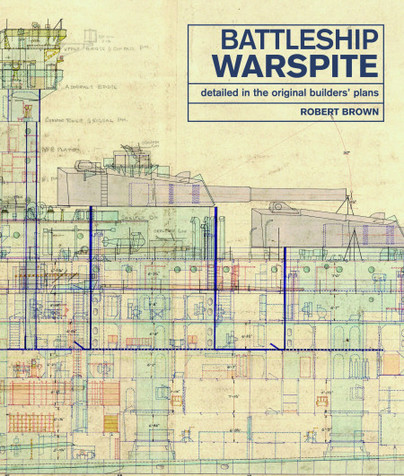
Battleship Warspite: Detailed in the Original Builders’ Plans. By Robert Brown. Seaforth Publications, Barnsley, 2017.
Reviewed by Gregory P. Gilbert
HMS ‘WARSPITE’ was one of the most famous ships of the first half of the 20th century. The battleship served throughout much of World War I. She was commissioned in 1915, fought with the 5th Battle Squadron at Jutland, was hit several times, was damaged in several accidents including two collisions, and was present at the surrender of the German High Sea Fleet on 21 November 1918. The ship was extensively modified several times during the 1920s and the 1930s until by 1939 HMS WARSPITE was almost unrecognisable compared with the WWI battleship.
During World War II she was a participant in many sea actions – in the Atlantic, with the Home Fleet (including action at Narvik in Norway), in the Indian Ocean, in the Mediterranean (at Matapan in 1940 and hit by an early guided missile at Salerno in 1943), and in North-Western Europe (at Normandy in 1944). Although there were proposals to retain WARSPITE as a museum ship she was decommissioned in early 1945 and finally scrapped and struck-off in 1947.
Today we can read the ship’s history in narrative form, either as part of the numerous histories of the many naval operations in which WARSPITE served or in one of a number of ship histories available – my personal favourite is Stephen Roskill’s ‘HMS Warspite: The Story of a Famous Battleship’ – but we do not get the feel of what it was like onboard. Ship models can provide a feel for the exterior of the original ship but it is impossible to model the interior details of the WARSPITE. Wouldn’t it be great to have access to the original builder’s plans for this ship?
Enter the latest offering by Seaforth Publishing and Robert Brown. What a superb idea – a collection of highly detailed reprints of the most important original drawings of HMS WARSPITE from the National Maritime Museum (UK). This is not just a very good reference book but a visual museum. The actual original ship’s drawings, of excellent quality, have been scanned at a high resolution and then reproduced in high quality versions. The drawings include; General Arrangement drawings for the original 1912-13 Battleships, General Arrangements (‘As-Fitted) for HMS MALAYA amended to 1929, General Arrangements (‘As-Fitted’) for HMS WARSPITE dated 1937, and a variety of HMS WARSPITE Detail Drawings from 1937 and 1941. Wherever possible detailed arrangements of compartments and specific items of equipment are reproduced in an enlarged format to ensure greater clarity. For an old naval designer, like myself, these drawings are truly remarkable.
Robert Brown has also provided comprehensive notes supporting each of the reproduced drawings. These include items such as; Structure, Main and Secondary Guns, Machinery, Protection, Fire Control, Searchlights, Masts and Aerials, and Aircraft arrangements. There are many items that will reward anyone who wishes to delve deeper within the arrangements of life on-board the ship. For instance it is interesting to compare the accommodation provided for the Admiral and his staff with that provided for other officers, senior sailors and junior sailors. Sleeping, eating and ablutions arrangements are all visible. For those interested in gunnery, it is possible to examine how munitions were stored, moved and ultimately aimed and fired within the ship. Each drawing can provide many hours of stimulation for someone who wishes to delve deeply into the details of a classic battleship.
Perhaps one of the less obvious details that come out of the pages of ‘Battleship Warspite’ is the amount of technical change that occurred within this single battleship over a lifetime of just over 30 years. Most books miss the point that naval technology is an ever changing beast. All battleships were significantly different – HMS DREADNOUGHT of 1905 was almost unrecognisable compared to USS NEW JERSEY 40 years later. For WARSPITE the simple bridge arrangement of 1913 grew in complexity as new instruments and techniques were adopted until by 1945 the WARSPITE’s bridge superstructure was extensive and multi-tiered. The propulsion machinery was totally upgraded, saving space as well as improving efficiency. Only the basic hull structure, the main armour and the type of 15-inch guns survived without major upgrade although even these had numerous modifications.
I can remember laying out the yards of coloured, linen arrangement drawings for several RAN ships. They were artworks involving many hours of drawing office labour by qualified draftsmen and tracers. By the time I commenced work in a drawing office the linen drawings were mostly obsolete, being replaced by plastic transparencies and various thicknesses of black ink. Computers soon took over and CAD became the new norm. I hope that the skills necessary to read information off technical drawings has not also become obsolete. I would hope that anyone who can read a modern digital general arrangement of a naval ship – perhaps as a minimum a damage control drawing – will also be able to read and enjoy the reproductions in ‘Battleship Warspite’. Unfortunately digital images on screens are just not the same as printed drawings or the original linens. The reproductions in ‘Battleship Warspite’ are the next best thing to a visit to view the originals in the National Maritime Museum (UK).
Robert Brown’s ‘Battleship Warspite: Detailed in the Original Builder’s Plans’ is an exciting new addition to my naval bookshelf. It is highly recommended for naval professionals and interested naval enthusiasts. The next books in this series ‘Cruiser Birmingham’ and ‘Aircraft Carrier Victorious’ should also be equally rewarding.



